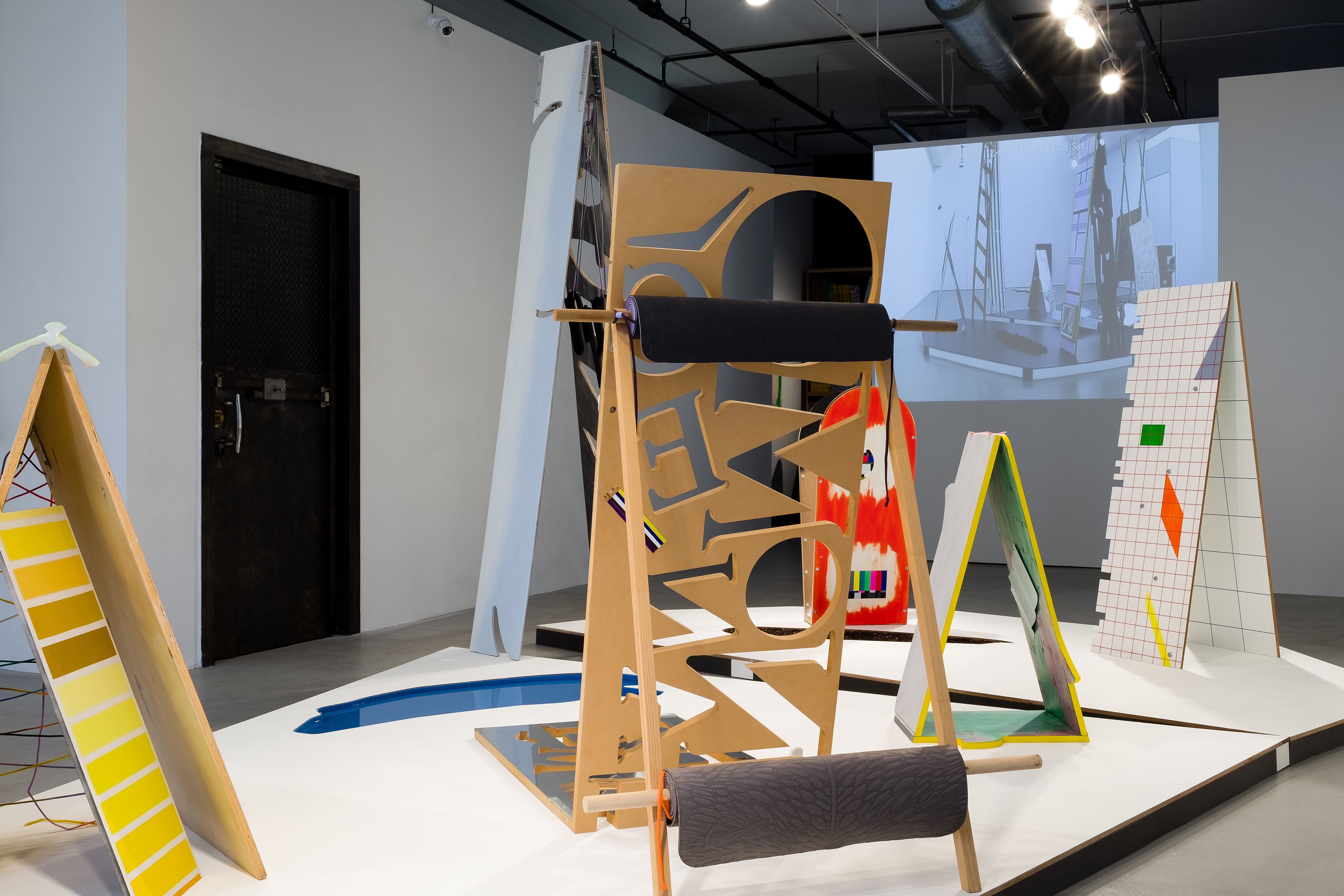…what dooms must do, standing still and walking in New York -Frank O’Hara, “Ode on Causality”, 1958
Simone Subal Gallery and Barbara Thumm Gallery are pleased to present Teen Factory, a solo exhibition by Anna K.E presented simultaneously in two galleries in New York and Berlin. K.E.’s two-part exhibition is an ode to life in these two places, and to a state of continual arrival.
K.E.’s work is highly attentive to the legacies of modernist architecture, and fragments from this history frequently appear in her work. Whether in the intimacy of a lap-bound sketchbook or scaled to her wide-open studio, K.E. embraces the architectural model as a simulation for thought – these utopic attitudes underlie drawings, sculptures, videos, varied works that translate space, both real and imaginary, through the body. For Teen Factory, a project which K.E. began more than two years ago, she has expanded her focus, allowing her attention to move beyond the immediate situation of studio sanctuary. Through simultaneous exhibitions in two cultural centers, K.E. has created environments that mirror one another, registering, through her personal and inscrutable constellations, that desire manifests without.
Each exhibition comprises a platform, a synthetic setting staged with a patch of grass, an abstract swath of dirt, and a small pool of water. Around these elements, K.E. has arranged a series of free-standing sculptures that any city-dweller will recognize as sandwich boards. They dot the built environment, line pedestrian walkways, direct passers-by to businesses adjacent, in front of, or around the corner from their station. Isn’t it a little sad and funny when a sandwich board has fallen over? For K.E., they are almost denizens of her community, expectant as any to be noticed, the minor choreographers of attention. Here is one of her sculptures in New York: contrappasto in raw plywood like a dancer, sewn together with bright rainbow-colored string, a plastic bird poised at the peak of its joinery. Here is one in Berlin: just over head height, stripes careen down its interior slope, odd-sized apertures sliced through the opposite board, the word “Anna” skillfully cut by hand, black lacquered, dangling in the dimension between its leaning uprights. Elsewhere: an inverted sandwich board, a cracked-open egg nested in its flat joint of a craw. Or another: Mickey-Mouse-racecar-cock leveled to the ground.
Scaled to the body, they cohere a chaotic, energetic hand with the high-craft of artistic industry – a juxtaposition of binary forces, the palpable tension of equilibriums. With a wooden base jig-sawed with ideograms – !, ?, *, etc. – one sandwich board, having sat for 2 years in the studio, was only completed when these symbols of agitated doubt and failure became its actual foundation. Is New York, or Berlin, or any other urban center, not gilded by youthful energy and perennially renewed by it? They are fed by this exuberance, and comfort by their ability to contain opposing ideas. In this way, K.E.’s sculptures perform; literally balanced at a point, they hold together the contradictory impulses of youthful desire and idealism. They crystalize and refract individual worlds, the joys and tragedies of collaged, geometrically multiplied selves.
The spectre of community haunts these exhibitions, however. CCTV systems installed in both galleries broadcast the installations live online, with footage from Berlin projected in New York and vice versa. If the sandwich boards were not already performing on their stages, the added element of surveillance finds them performing for each other, for the audiences in the galleries, or any interested party online. Like the sculptures themselves, the intrusion of the cameras’ stare harkens on the paranoia of urban space; but if this footage is at all invasive, it also shows the sculptures, like the foreign art communities, as distant, mirrored, conjoined halves of the same self. After dark is perhaps when the sculptures have their most poignant effect: why do we keep the lights on all night? For a surrogate community or a sense of foreboding. Perhaps, as the title invokes the teen, the experience vibrates with expectation, the pleasure and insecurity of completing the scene.
K.E. originally envisioned hedgehogs roaming through the exhibitions. They are absent, but haunt Teen Factory still. Like naturalistic Zoo environments with no animal to be seen, they resonant with the tension of absence. K.E. evokes a similar character, alluded to in the installations, yet wandering outside the galleries’, or CCTV systems’ frame. In a video presented adjacent to the stage, K.E. walks, juts, darts backwards throughout her studio. Arms wrapped around herself, hands writhing like budding wings, she dodges the outstretched hand extended from behind the camera. She grunts and screeches, it is the score for the exhibition, the pre-verbal sounds humans make. K.E. performs an ad hoc slapstick of observation and isolation –feelings of becoming monstrous and public. It is an imaginary city in which K.E., like a teen, intuits a world of desire in people here as elsewhere; and in the video, Teen Factory finds its character, the one for whom it makes this homage. An energy, conveyed from place to place, approximate to the body.
-Sam Korman, September 2015

























































































































